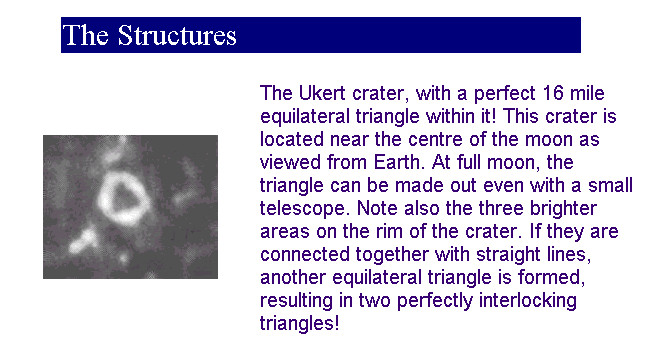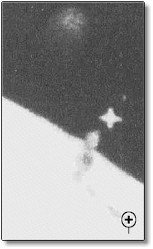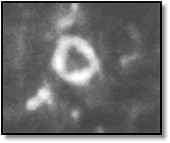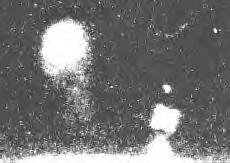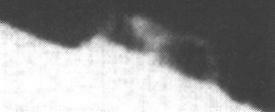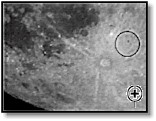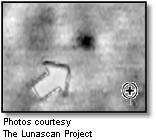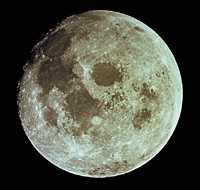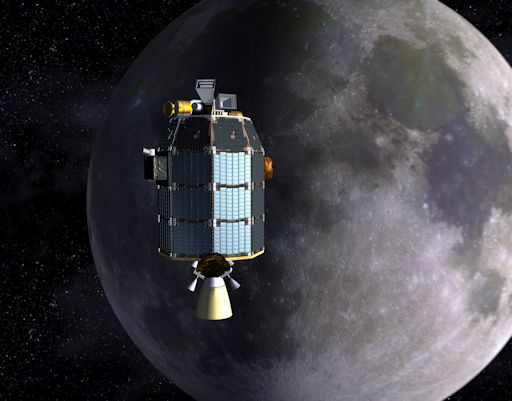| I don't see any written evidence that we in the U.S.
were being 'attacked' by UFOs in the 40's, but I do see evidence that we
were afraid of them. Later evidence shows that Germany had knowledge
of UFOs way before we did in the U.S. Germany was way ahead of the
U.S. in shooting down UFOs and using the technology to try to win
WWII.
I have yet to see any evidence of the reason why so many UFOs were crashing.
It seems rather iffy to think that UFOs flew to earth and then couldn't handle
flying in the air for whatever reason. Films/videos show too much evidence
that they have excellent control over their vehicles, and their vehicles
weren't of the caliber of our first meager efforts to fly in planes made
of bicycle parts and balsa wood.. Their vehicles were made of
such technology that we couldn't even figure out what they were made of,
nor how they were flown. The evidence shows that they were caught in lightening
storms and were shot down by the military in Germany and the U.S.
The Apollo program was instituted because of the fear that a military
base was going to be established on the far side of the moon and whoever
got there first, whether human (Russia) or the extraterrestrials, who we
were in dire fear of, would be in control of earth. No matter what
the cost, either in dollars or lives, the U.S. had to win that race to the
dark side of the moon.
By then, Germany had lost WWII and we were now on even footing with Russia
as far as brains go. At the end of WWII, Russia got half of the brains out
of Germany, and the U.S. got the other half. Perhaps knowing what we
know now, we should have demanded all the brains, but we didn't. Through
what we called Operation Paperclip, we got some characters (Nazi's if you
will) who were responsible for killing millions of people. That was the level
of our desperation.
The U.S. Military rounded up Nazi scientists and brought them to America.
It had originally intended merely to debrief them and send them back to Germany.
But when it realized the extent of the scientists knowledge and expertise,
the War Department decided it would be a waste to send the scientists home.
Following the discovery of flying discs (foo fighters), particle/laser beam
weaponry in German military bases, the War Department decided that NASA and
the CIA must control this technology, and the Nazi engineers that had worked
on this technology.
There was only one problem: it was illegal. U.S. law explicitly prohibited
Nazi officials from immigrating to America--and as many as three-quarters
of the scientists in question had been committed Nazis. Military Intelligence
"cleansed" the files of Nazi references. By 1955, more than 760 German scientists
had been granted citizenship in the U.S. and given prominent positions in
the American scientific community. Many had been longtime members of the
Nazi party and the Gestapo, had conducted experiments on humans at concentration
camps, had used slave labor, and had comitted other war crimes.
Here are some more notable ones:
ARTHUR RUDOLPH;
During the war, Rudolph was operations director of the Mittelwerk factory
at the Dora-Nordhausen concentration camps, where 20,000 workers died from
beatings, hangings, and starvation. Rudolph had been a member of the Nazi
party since 1931; a 1945 military file on him said simply: "100% Nazi, dangerous
type, security threat..!! Suggest internment."
WERNHER VON BRAUN;
From 1937 to 1945, von Braun was the technical director of the Peenemunde
rocket research center, where the V-2 rocket --which devasted England--was
developed. As noted previously, his dossier was rewritten so he didn't appear
to have been an enthusiastic Nazi.
Von Braun worked on guided missles for the U.S. Army and was later director
of NASA's Marshall Space Flight Center. He became a celebrity in the 1950s
and early 1960s, as one of Walt Disney's experts on the "World of Tomorrow."
In 1970, he became NASA's associate administrator.
KURT BLOME;
A high-ranking Nazi scientist, Blome told U.S. military interrogators in
1945 that he had been ordered 1943 to experiment with plague vaccines on
concentration camp prisoners. He was tried at Nuremberg in 1947 on charges
of practicing euthanasia (extermination of sick prisoners), and conducting
experiments on humans. Although acquitted, his earlier admissions were well
known, and it was generally accepted that he had indeed participated in the
gruesome experiments. Two months after his Nuremberg acquittal, Blome
was interviewed at Camp David, Maryland, about biological warfare. In 1951,
he was hired by the U.S. Army Chemical Corps to work on chemical warfare.
His file neglected to mention Nuremberg.
MAJOR GENERAL WALTER SCHREIBER;
The US military tribunal at Nuremberg heard evidence that "Schreiber had
assigned doctors to experiment on concentration camp prisoners and had made
funds available for such experimentation." The assistant prosecutor said
the evidence would have convicted Schreiber if the Soviets, who held him
from 1945 to 1948, had made him available for trial. Again, Schreiber's Paperclip
file made no mention of this evidence; the project found work for him at
the Air Force School of Medicine at Randolph Field in Texas. When columnist
Drew Pearson publicized the Nuremberg evidence in 1952, the negative publicity
led the JIOA, says Hunt, to arrange "a visa and a job for Schreiber in Argentina,
where his daughter was living." On May 22, 1952, he was flown to Buenos
Aires.
HERMANN BECKER-FREYSING and SIEGFRIED RUFF;
These two, along with Blome, were amoung the 23 defendants in the Nuremberg
War Trials "Medical Case." Becker-Freysing was convicted and sentenced to
20 years in prison for conducting experiments on Dachau inamtes, such as
starving them, then force-feeding them seawater that had been chemically
altered to make it drinkable. Ruff was acquitted (in a close decision) on
charges that he had killed as many as 80 Dachau inmates in a low-pressure
chamber designed to simulate altitudes in excess of 60,000 feet. Before their
trial, Becker-Freysing and Ruff were paid by the Army Air Force to write
reports about their grotesque experiments.
GENERAL REINHARD GEHLEN;
It was five years after the end of WW2 but one of Hitler's chief intelligence
officers was still on the job. From a walled-in compound in Bavaria, General
Reinhard Gehlen oversaw a vast network of intelligence agents spying on Russia.
His top aides were Nazi zealots who had committed some of the most notorious
crimes of the war. Gehlen and his SS united were hired, and swiftly became
agents of the CIA when they revealed their massive records on the Soviet
Union to the US. Gehlen derived much of his information from his role
in one of the most terrible atrocities of the war: the torture, interrogation
and murder by starvation of some four million Soviet prisoners. Prisoners
who refused to cooperate were often tortured or summarily executed. May were
executed even after they had given information, while others were simply
left to starve to death. As a result, Gehlend and members of his organization
maneuvered to make sure they were captured by advancing American troops rather
than Russians, who would have executed them immediately. With the encouragement
of the CIA, Gehlen Org (Licio Gelli) set up "rat lines" to get Nazi war criminals
out of Europe so they wouldn't be prosecuted. By setting up transit camps
and issuing phony passports, the Gehlen Org helped more than 5,000 Nazis
leave Europe and relocate around the world, especially in South and Central
America.
KLAUS BARBIE;
Known as the Nazi butcher of Lyons, France during World War 2, Barbie was
part of the SS which was responsible for the and death of thousands of French
people under the Germany occupation.
HEINRICH RUPP;
Some of Rupp's best work was done for the CIA, after he was imported in Operation
Paperclip. Rupp has been convicted of bank fraud. He was an operative for
the CIA and is deeply involved in the Savings and Loan scandals. A federal
jury has indicated they believe testimony that Rupp, the late CIA Director
William Casey - then Reagan's campaign manager, and Donald Gregg, now U.S.
Ambassador to South Korea, flew with George Bush to Paris in 1980, during
the election in which Bush was on the ticket with Ronald Reagan. The testimony
states that three meetings were held on October 19 and 20 at the Hotel Florida
and Hotel Crillion. The subject? According to the court testimony, the meetings
were to sabotage President Jimmy Carter's reelection campaign by delaying
the release of American hostages in Iran. The hostages were released on January
20, 1981, right after Reagan and Bush were sworn into office. Iran was promised
return of its frozen assets in the United States and the foundation for the
Iran- Contra deal was set into motion.
LICIO GELLI;
Head of a 2400 member secret Masonic Lodge, P2, a neo-fascist organization,
in Italy that catered to only the elite, Gelli had high connections in the
Vatican, even though he was not a Catholic. P2's membership is totally secret
and not even available to its Mother Lodge in England. Gelli was responsible
for providing Argentina with the Exocet missile. He was a double agent for
the CIA and the KGB. He assisted many former Nazi high officials in their
escape from Europe to Central America. He had close ties with the Italian
Mafia. Gelli was a close associate of Benito Mussolini. He was also closely
affiliated with Roberto Calvi, head of the scandal-ridden Vatican Bank. Calvi
was murdered. Gelli's secret lodge consisted of extremely important people,
including armed forces commanders, secret service chiefs, head of Italy's
financial police, 30 generals, eight admirals, newspaper editors, television
and top business executives and key bankers - including Calvi. Licio Gelli
and others in P2 were behind the assassination of Pope John Paul 1. While
on one hand, the U.S. participated in the war crime tribunals of key Nazi
officials and maintained an alliance with the Communist Soviet Union, secretly,
the U.S. was preparing for the cold war and needed the help of Nazis in the
eventual struggle the U.S. would have with the Soviet Union. Gelli's agreement
with U.S. intelligence to spy on the Communists after the war was instrumental
in saving his life. He was responsible for the murder and torture of hundreds
of Yugoslavian partisans.
Project Paperclip was stopped in 1957, when West Germany protested to the
U.S. that these efforts had stripped it of "scientific skills." There was
no comment about supporting Nazis. Paperclip may have ended in 1957, but
as you can see from Licio Gelli and his international dealings with the CIA
in Italy/P2, and Heinrich Rupp with his involvement in October Surprise,
the ramifications of Paperclip are world-wide. The Nazis became employed
CIA agents, engaging in clandestine work with the likes of George Bush, the
CIA, Henry Kissenger, and the Masonic P2 lodge. This is but one of the results
of Operation Paperclip. Another umbrella project that was spawned from Paperclip
was MK-ULTRA.
So, there are a few choice personnel who helped the U.S. to go to the moon
in the Apollo project. If you think by now that we were just kidding around,
you need to re-read the above until you realize that we meant business.
We were going to win the cold war, get control of the world whether against
the Russians and/or the extraterrestrials or both. To be honest ...
it was more against the extraterrestrials than the Russians, but the Russians
provided the excuse the U.S. needed so that we didn't have to admit that
Roswell was about a real crashed UFO. That kind of knowledge was kept
from the Americans who were deemed to be too emotional and panicky, and would
get out of control to know that the whole history they believed in
was a lie. And that includes their religious history.
Wernher Von Braun was one of the world's first and foremost rocket engineers
and a leading authority on space travel. His will to expand man's knowledge
through the exploration of space led to the development of the Explorer
satellites, the Jupiter and Jupiter-C rockets, Pershing, the Redstone rocket,
Saturn rockets, and Skylab, the world's first space station. Additionally,
his determination to "go where no man has gone before" led to mankind setting
foot on the moon.
Living in Huntsville, Alabama from 1950 to 1970, Dr. von Braun first
directed the technical development of the U.S. Army's ballistic missile program
at Redstone Arsenal, and later served as Director of NASA's Marshall Space
Flight Center. When he transferred to Washington, D.C., he left Huntsville
with a rich legacy: the research institutions at the University of Alabama
in Huntsville, the Alabama Space and Rocket Center, and the Von Braun Civic
Center.
He enrolled at the Berlin Institute of Technology in 1930. In 1932, at
the age of 20, he received his bachelor's degree in mechanical engineering,
and was offered a grant to conduct and develop scientific investigations
on liquid-fueled rocket engines. Two years later, Wernher received his PhD
in physics from the University of Berlin.
During the 30's the German military was searching for a weapon which
would not violate the Versailles Treaty of World War I, and at the same time
defend Germany. By 1934 von Braun and Walter Dornberger had a team of 80
engineers building rockets in Kummersdorf, about 60 miles south of Berlin.
Von Braun's natural talents as a leader shone, as well as his ability to
assimilate great quantities of data while keeping in mind the big picture.
With the successful launch of two rockets, Max and Moritz, in 1934, von Braun's
proposal to work on a jet-assisted take-off device for heavy bombers and
all-rocket fighters was granted. However, Kummersdorf was too small for the
task, so a new facility had to be built.
By now Hitler had taken over Germany and Herman Goering ruled the Luftwaffe.
Dornberger held a public test of the A-2 which was greatly successful. Funding
continued to flow to von Braun's team, developing the A-3 and finally the
A-4.
1934 - First treaty with Greys aboard U.S. naval ship off Balboa. Hitler
evokes "Law for Removing the Distress of People and Nation"; which overnight,
eliminates power of Political Parties, State Institutions and Trade Unions
while also
extinguishing the personal liberty of every citizen of the Reich.
1938 - Evidence of German recovery of downed Alien craft. Construction of
advanced Luftwaffe aircraft begins at underground research facilities:
Reineckendorf, Kummeradorf and Thuringia.
U.S. government backs "War Of The Worlds" broadcast in order to gauge public
reaction to Alien invasion scenario.
Hitler invades Austria and claims Spear of Longinus. Adolph Hitler views
Spear of Longinus; believed to be the same spear
that pierced the crucified Christ's side, which he had viewed for first time
at Hofburg treasure house in 1909.
1939 - World War 2 begins. Nazi Alien technology compromised by necessity
for jet propulsion,
which keeps gravitational R&D effort in labs for duration of
war.
1941 - German underground excavation begins in Antarctica.
In 1943 Hitler decided to use the A-4 as a "vengeance weapon," and the
group found themselves developing the A-4 to rain explosives on London. Fourteen
months after Hitler ordered it into production, the first combat A-4, now
called the V-2, was launched toward western Europe on September 7, 1944.
When the first V-2 hit London von Braun remarked to his colleagues, "The
rocket worked perfectly except for landing on the wrong planet."
The SS and the Gestapo arrested von Braun for crimes against the state
because he persisted in talking about building rockets which would go into
orbit around the Earth and perhaps go to the Moon. His crime was indulging
in frivolous dreams when he should have been concentrating on building bigger
rocket bombs for the Nazi war machine. Dornberger convinced the SS and the
Gestapo to release von Braun because without him there would be no V-2 and
Hitler would have them all shot.
On arriving back at Peenemunde, von Braun immediately assembled his planning
staff and asked them to decide how and to whom they should surrender. Most
of the scientists were frightened of the Russians, they felt the French would
treat them like slaves, and the British did not have enough money to afford
a rocket program. That left the Americans. After stealing a train with forged
papers, von Braun led 500 people through war-torn Germany to surrender to
the Americans. The SS were issued orders to kill the German engineers, who
hid their notes in a mine shaft and evaded their own army while searching
for the Americans. Finally, the team found an American private and surrendered
to him. Realizing the importance of these engineers, the Americans immediately
went to Peenemunde and Nordhausen and captured all of the remaining V-2's
and V-2 parts, then destroyed both places with explosives. The Americans
brought over 300 train car loads of spare V-2 parts to the United States.
Much of von Braun's production team was captured by the Russians.
On June 20, 1945, U.S. Secretary of State Cordell Hull approved the transfer
of von Braun's German rocket specialists. This transfer was known as Operation
Paperclip because, of the large number of Germans stationed at Army Ordnance,
the paperwork of those selected to come to the United States were indicated
by paperclips.
They arrived in the United States at New Castle Army Air Base, just south
of Wilmington, DE. Afterwards, they were flown to Boston, and then taken
by boat to an Army Intelligence Service post at Fort Strong in Boston Harbor.
Later, with the exception of von Braun, the men were transferred to Aberdeen
Proving Grounds in Maryland to sort out the Peenemunde documents. Those documents
would enable the scientists to continue their rocketry experiments where
they had left off.
Finally, von Braun and the 126 Peenemunders were transferred to their
new home at Fort Bliss, Texas, a large Army installation just north
of El Paso, under the command of Major James P. Hamill. They found themselves
in a strange situation as they began their new lives in America. Because
they could not leave Fort Bliss without a military escort, they sometimes
referred to themselves as "PoPs", Prisoners of Peace.
While at Fort Bliss, they were tasked to train military, industrial,
and university personnel in the intricacies of rockets and guided missiles
and to help refurbish, assemble, and launch a number of V-2's that had been
shipped from Germany to the White Sands Proving Grounds in New Mexico. Further,
they were to study the future potential of rockets for military and research
applications.
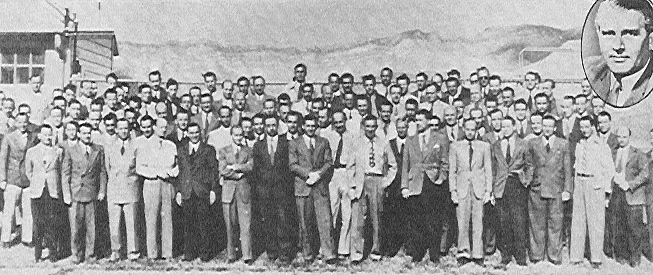
A 1947 photo of the German team at Fort Bliss, Texas. Dr. von Braun, inset,
is in the front row, seventh from right. Operation Paperclip came to a fitting
conclusion with the naturalization of the first group of more than 50 German
scientists and technicians on November 11, 1954, in Birmingham, Alabama.
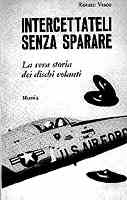 Renato Vesco Renato Vesco
This Italian aeronautical technician claimed modern "flying saucers" are
the Anglo-Canadian development of very advanced German projects, namely the
circular unmanned crafts "Feuerball" and "Kugelblitz". Both of them were
in the prototype stage and maybe they were even flown-tested just at the
end of the war. Vesco and his impressive documentation have been often used
by many later authors in order to try to substantiate their empty claims.
The first book of Renato Vesco was published in 1968, but the original manuscript
was ready since 1956. Because of job engagements he stopped its publication
and went on collecting more material. So he had enough material to write
three large books.
The first one had a Spanish edition and two in US (1971, Grove and 1974,
Zebra), soon becoming a reference work for most but all the authors and
researchers writing about the highly controversial subject of German "flying
saucers". In 1994, the book was nearly fully reprinted within a book edited
by D.Childress "Man-Made UFOs 1944-1994".
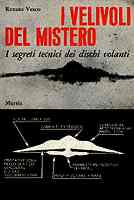 Here is the
second Vesco book. Here is the
second Vesco book.
The author was born in Arona in 1924. He died in November 1999 in Genoa,
the town where he had been living for many years. Since some years he was
writing a new manuscript to publish a fourth "ultimate" book. The huge archive
of Vesco has been retrieved safely and now preserved from destruction. The
inventory should allow to find and evaluate some of the original sources
used by the author.
 The third book
by Renato Vesco is a thick 553-page volume loaded with a real wealth of info.
On the ground of some late war German projects (including the Norvegian-based
development of the original Belluzzo's blueprints and the German atom bomb
project) and post-war British breakthroughs in aeronautics and astronautics,
he pointed out a fascinating but hard-to-believe scenario. The third book
by Renato Vesco is a thick 553-page volume loaded with a real wealth of info.
On the ground of some late war German projects (including the Norvegian-based
development of the original Belluzzo's blueprints and the German atom bomb
project) and post-war British breakthroughs in aeronautics and astronautics,
he pointed out a fascinating but hard-to-believe scenario.
British spaceships had been built after blueprints and technology captured
in Germany and flown since 1947. In 1951 they landed on the Moon and in 1954
they reached Mars. Though these claims look quite unlikely and unsubstantiated,
most of the evidence and sources offered by Vesco lead to some interesting
considerations about German secret technology and some late '40s and '50s
UFO sightings.
 Following the
Canadian AVRO CAR project rumours, many magazines of the early '50s published
news about soon-to-come man-made "flying saucers". Vesco found in these
rumours more background for his theory. Following the
Canadian AVRO CAR project rumours, many magazines of the early '50s published
news about soon-to-come man-made "flying saucers". Vesco found in these
rumours more background for his theory.
 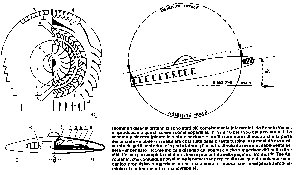
Other sketches of wanna-be man-made flying saucers. Besides the official
AVRO project, there were tens of inventors with plans of fantastic flying
machines, often related to revolutionary discoveries with
anti-gravity.
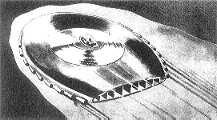 The concept
of the "man-made flying saucer" was really exciting and even welcome in an
era of fast technological advancements. The wonders of science and technology
of the atomic age could well explain even a dream-machine like the flying
saucer. The concept
of the "man-made flying saucer" was really exciting and even welcome in an
era of fast technological advancements. The wonders of science and technology
of the atomic age could well explain even a dream-machine like the flying
saucer.
 The well-known
aviation magazine "Flying" devoted some space to the idea of a circular aircraft
as the ultimate air weapon. The well-known
aviation magazine "Flying" devoted some space to the idea of a circular aircraft
as the ultimate air weapon.
1945 - World War 2 ends with geographic defeat of Axis powers and panic
exodus of high proportion of remaining Jews from continent. A crew-carrying
the "Kugelblitz" flies from Thuringia. Kugelblitz engines were extracted
and ship destroyed by SS. Scientists, plans and engines were shipped to
Antarctica, where
Fourth Reich White Wolves regroup.
There is some evidence to show that the 'flying saucers' seen by Kenneth
Arnold over Mt. Rainier in Washington State were of
'German'
origin, and not flown by aliens. |

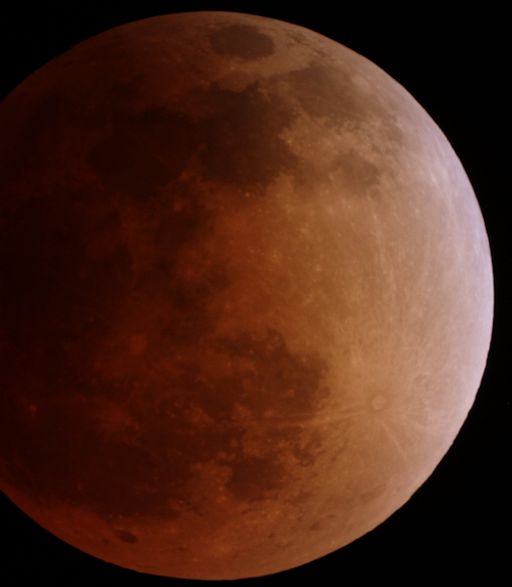


 Renato Vesco
Renato Vesco Here is the
second Vesco book.
Here is the
second Vesco book. The third book
by Renato Vesco is a thick 553-page volume loaded with a real wealth of info.
On the ground of some late war German projects (including the Norvegian-based
development of the original Belluzzo's blueprints and the German atom bomb
project) and post-war British breakthroughs in aeronautics and astronautics,
he pointed out a fascinating but hard-to-believe scenario.
The third book
by Renato Vesco is a thick 553-page volume loaded with a real wealth of info.
On the ground of some late war German projects (including the Norvegian-based
development of the original Belluzzo's blueprints and the German atom bomb
project) and post-war British breakthroughs in aeronautics and astronautics,
he pointed out a fascinating but hard-to-believe scenario. Following the
Canadian AVRO CAR project rumours, many magazines of the early '50s published
news about soon-to-come man-made "flying saucers". Vesco found in these
rumours more background for his theory.
Following the
Canadian AVRO CAR project rumours, many magazines of the early '50s published
news about soon-to-come man-made "flying saucers". Vesco found in these
rumours more background for his theory. The concept
of the "man-made flying saucer" was really exciting and even welcome in an
era of fast technological advancements. The wonders of science and technology
of the atomic age could well explain even a dream-machine like the flying
saucer.
The concept
of the "man-made flying saucer" was really exciting and even welcome in an
era of fast technological advancements. The wonders of science and technology
of the atomic age could well explain even a dream-machine like the flying
saucer. The well-known
aviation magazine "Flying" devoted some space to the idea of a circular aircraft
as the ultimate air weapon.
The well-known
aviation magazine "Flying" devoted some space to the idea of a circular aircraft
as the ultimate air weapon.
